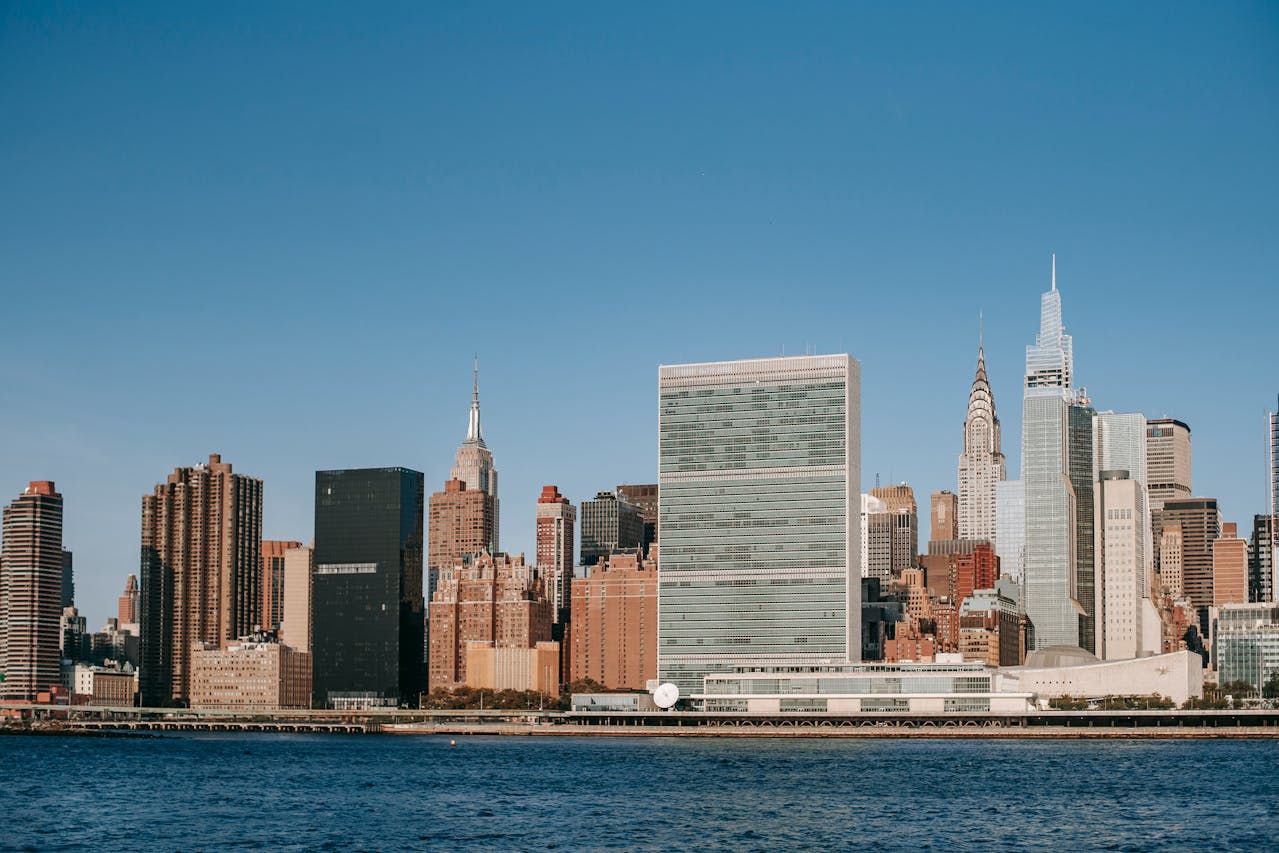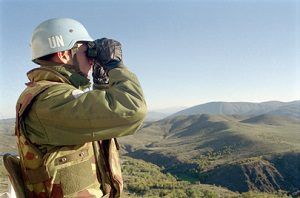

Global Peace Operations Review
Creating a “Responsibility to Prevent” at the UN
Much of the High-Level Thematic Debate (HLTD) on Peace and Security in the General Assembly in May was predictably centred on prevention. Participants made the case for greater efforts to prevent conflict from erupting or re-erupting in the first place and committing to sustaining peace. But maybe it is time, as Youssef Mahmoud has argued, for prevention as a term to be disconnected from conflict?

This would entail moving towards a notion of “positive peace” as first coined by Johan Galtung; a comprehensive approach to identifying and nurturing the attitudes, institutions and structures, which we know create societal resilience and sustainable peace by addressing root causes and potential triggers of conflict long before conflict turns violent.
In line with this thinking, others have argued that assistance to the prevention of conflict should apply similar approaches as efforts to prevent diseases by improving public health. Medical practitioners and experts have known for centuries that enhancing prevention decreases the need for expensive cures. Similarly, efforts to sustain peace should focus on developing permanent local agency and capacity to prevent conflict that might turn violent – just as we do when ensuring cold chains, improving medical education, rolling out public health campaigns and introducing vaccination programs to prevent diseases.
The discussions during the HLTD also demonstrated that the three key peace and security reports of 2015, with their crosscutting focus on prevention and sustaining peace, are now triggering a range of reflections on our approaches to, and understanding of, efforts to address the risks of violent conflict.
Making prevention a reality in the UN System
Reflection is good and collective reflection even better when the aim is to advance a global understanding of the most critical challenges relating to preventing violent conflict. However, at some point one needs to look for the tangible changes these discursive shifts may or may not bring about. Much of the discussion during the HLTD dealt with the capacity and ability of the UN System to support preventive efforts.
One discussion focused on the proposal to strengthen the Department of Political Affairs’ mediation and preventive diplomacy capacity as well as its early warning mechanisms. This would necessitate expanded, professionalised and more rapidly deployable mediation capacities and an increased use and spread of political envoys and good offices. Such improvements and expansions ought to be a no-brainer for those Member States expected to foot the bill. Preventive actions cost a fraction of any form of response to the outbreak of violent conflict. Needless to say that the self-evident nature of these investments will not automatically lead to Member State action in times marked by siloed financing and diminishing investments in the UN System from a range of donor countries.
Making prevention work outside the UN System
While the discussions of the UN System’s mediation capacities and approaches remain extremely relevant, the focus on institutional fixes and capabilities also provide a convenient excuse to walk around the elephant in the room: the political dynamics and decisions that often lead to indecision and inaction when it comes to early prevention efforts and commitment to finding political solutions. Most of the seemingly intractable, protracted, and bloody conflicts we face today have little to do with the UN’s mediation capacity or the number of regional envoys. Their protraction and intractability are caused by the lack of appetite of local, national, regional or geopolitical actors to find viable political compromises, solutions and settlements. In fact, many of the conflicts transcend the interests, positions and worldviews of local actors and have instead become either proxy wars waged by regional actors or/and have fallen prey to geopolitical endeavours to project power and influence. The three reviews of last year also fully acknowledged this primacy of politics when it comes to sustaining peace.
This recognition evidently begs the question: What do we do when the question is not about mediation capacities and finding the most effective arrangements for international assistance to prevent violent conflict but about the deliberate reluctance of key actors to activate these capacities and forms of assistance? The big question here – the size of the elephant in the room – is, whether the UN’s Member States are ready to agree to obligating and committing principles ensuring that local, regional or geopolitical interests or proxy interest are not allowed to prevent prevention i.e. that preventive efforts can bypass political deadlocks and decision-making impasse by calling on the Responsibility to Prevent.
Responsibility to Prevent as a framework for action?
The semantic reference to the Responsibility to Protect (R2P) is neither accidental nor an attempt to ignore the history of contestation and disagreement around R2P as a concept. One of the on-going tensions concerning the role of the United Nations in maintaining international peace and security continues to relate to state sovereignty and interference therein. The UN Charter grants the Security Council the power to authorise interfering, including with military means, in the internal affairs of any country in the world if a situation posses a threat to international peace and security.
In recent decades, peacekeeping missions have indeed increasingly been deployed to deal with intra-state conflict and civil war – and increasingly without the full content of the belligerent parties. There have, however, also been several examples of inaction or inadequate action by the Security Council mainly linked to one or more permanent members of the Security Council vetoing decisions to intervene out of geopolitical interests, concerns over breaching state sovereignty or using the latter argument to cover over the former.
The R2P principles were endorsed by all member states of the United Nations at the 2005 World Summit to “prevent genocide, war crimes, ethnic cleansing and crimes against humanity”. The principles would allow the international community to respond, including through military means, if and when a range of criteria were met and a set if principles applied. These principles stressed that intervention, including the use of force based on R2P principles, could only happen as a means of last resort. Protecting civilians would remain the primary responsibility of the individual state, the international community would commit to assisting a state in its efforts to protect its civilian population and only in cases where the state proved unwilling or unable to adequately protect its citizens would an R2P intervention be warranted – but in these situations no longer as a choice but rather as a responsibility.
Responsibility to Prevent principles
If UN Member States were to endorse a principle of Responsibility to Prevent (an R2P v.2), similar principles should apply i.e. that states themselves carry the primary responsibility to prevent conflict – if needed supported by the international community. Only in cases where countries fail to sustain peace would the Security Council or other international actors initiate preventive efforts.
The main difference between the responsibility to protect and that to prevent would be a) the absence of the use of force in preventive efforts) at least under the Responsibility to Prevent principles) and b) action at the earliest possible stages of emerging conflict – ideally before conflict turns violent at all and thus addressing root causes and potential triggers of conflict. A such, the Responsibility to Prevent should appear significantly less threatening to Member States worried about the Responsibility to Protect principles being used to authorise and expand the use of force beyond the original intention and lacking appropriate proportionality as well as a realistic end stage. Those following the application of the R2P principles will recall such concerns expressed with regards to past interventions namely in Libya in 2011.
Operationalizing Responsibility to Prevent
The increased political and institutional focus on prevention obviously begs the question what prevention actually means in more “operational terms”. While there is no single answer to this question, efforts might include the establishment of Good Offices and/or deployment of a mediator or a team of mediators to a country or region displaying distressing signs of tension and inability to sustain peace. This would include addressing structural root causes of conflict and thus involve a much broader understanding of what sustains peace along the lines of the positive peace vision embodied in the sustainable development goals and namely goal 16.
The principles of Responsibility to Prevent could empower the General Assembly to refer prevention concerns to the Security Council making it a standing item on the Council’s agenda without giving the Council’s permanent members the opportunity to block or remove the agenda item.
Also, early action evidently depends on early knowledge and acknowledgement. Implementing the principles of Responsibility to Prevent would therefore require an in-depth understanding of – often latent – conflict drivers at the local, national and regional levels. The principles are consequently linked to enhancing the capacity of the UN System and local actors to identify early indications of escalating conflict. From a UN angle this is currently particularly challenging in countries with no “political presence” of the UN System i.e. no peacekeeping or political mission and no political envoy covering the territory. Circling back to DPS’s call for enhanced coverage and capacity, such presences must be expanded and capacitated to fulfil this role.
The Responsibility to Prevent could also entail the issuance of Security Council resolutions requesting local stakeholders showing signs of division to engage constructively in negotiations – potentially accompanied by punitive measures (through sanctions panels and monitoring groups) towards parties failing to comply. The Security Council might also request a regional organisation to initiate preventive efforts or endorse and support (including financing) a regional organisation already doing so. Responsibility to Prevent could also mean that the Security Council will keep a prevention challenge in a given country as a standing item on its agenda until a political settlement leading to sustainable peace has been identified and implemented.
The Security Council could also request, and the Secretary-General could support through the Secretariat, the development and implementation of national road maps for prevention including through building early warning systems, institutional response mechanisms and longer-term strategies to ensure political, and socio-economic inclusivity and cohesion. In many contexts, this will require significant investments from external bilateral and multilateral actors. While this is true for all preventive work, post-conflict situations are likely to require particularly substantial investments to deal with the trauma and legacy of conflict – including the physical destruction, absence of sustainable livelihoods and economic opportunity.
Hence, there is a need for not only increased but also predictable financing if efforts to sustain peace are to prevail. Ensuring adequate, predictable and sustained financing for peacebuilding, including for conflict prevention at the earliest stages of potential conflict, was one of the unresolved issues in the recently adopted resolution on peacebuilding. The question was left for the incoming Secretary-General to consider and return with options for the membership to consider during the seventy-second session of the General Assembly.
Finally, the principles of Responsibility to Prevent could empower the General Assembly to refer prevention concerns to the Security Council making it a standing item on the Council’s agenda without giving the Council’s permanent members the opportunity to block or remove the agenda item. While this is unlikely to change potential geopolitical dynamics it could, at least, help to making these known to the broader global public and discussed (and criticised) out in the open.
Conclusion
The recent reviews of the UN’s role in maintaining international peace and security and the subsequent momentum in terms of UN and Member State attention, marks somewhat of a leap forward in our conceptual understanding of efforts to sustain peace. They reinforce the understanding that prevention must be put front and centre at the earliest stages of potential conflict while, and by, acknowledging the primacy of politics in efforts to sustain peace. This requires reformed and enhanced efforts within the UN System.
The acknowledgement of the primacy of politics highlights the limitations of the UN System and the critical role played its Member States in supporting prevention thorough addressing political root causes of conflict and supporting fair and inclusive political settlements. There are cases where local, regional or geopolitical interests stand in the way of such dedicated and serious prevention efforts. These deadlocks could potentially be addressed by introducing the principles of Responsibility to Prevent.
These are some very premature ideas about what such principles could entail and how they could be operationalized. It is now up the UN’s Member States to complement the needed institutional fixes with genuine Member State action. A binding agreement on the Responsibility to Prevent and its operational implications could be an important step in this direction.
Kristoffer Tarp is an analyst at the Danish Institute for International Studies. Twitter |@KristofferTarp
More Resources
-

-

As Prevention Gains Momentum with UN Member States, What's Next?
-
Stay Connected
Subscribe to our newsletter and receive regular updates on our latest events, analysis, and resources.
"*" indicates required fields


